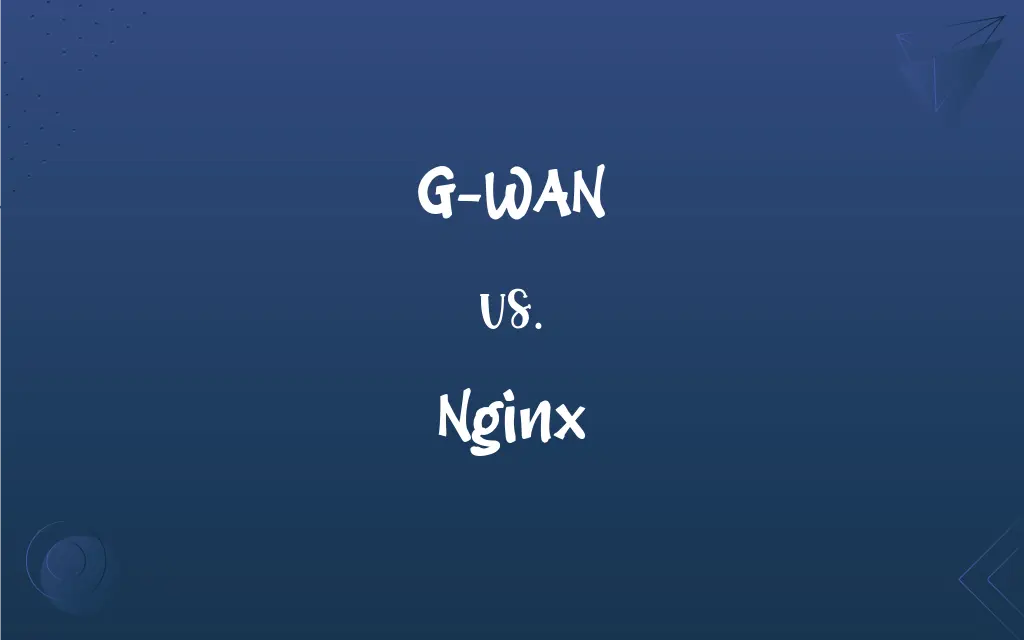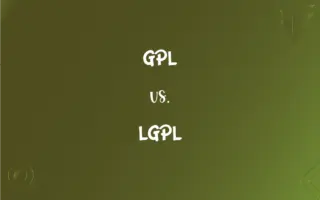G-WAN vs. Nginx: What's the Difference?
Edited by Janet White || By Harlon Moss || Updated on October 23, 2023
G-WAN is a high-performance web server focusing on C scripts, while Nginx is a versatile web server, reverse proxy, and load balancer.

Key Differences
G-WAN is a web server designed primarily to execute C scripts, known for its speed and efficient concurrency model. Nginx, on the other hand, is renowned for its performance, flexibility, and capability to handle many connections simultaneously.
G-WAN boasts an in-memory application server, aiming to deliver high-speed responses by leveraging C/C++ code. Nginx focuses on a non-blocking, event-driven architecture, allowing for efficient processing of simultaneous requests.
When it comes to adaptability, Nginx shines with its vast array of modules and plugins, offering functionalities like HTTP/2 and TLS. In contrast, G-WAN promotes itself as lightweight and free from the need for numerous modules or add-ons due to its architecture.
G-WAN is often praised for its sheer speed and minimalism, focusing on serving web applications quickly without much overhead. Nginx, while also known for speed, offers a broader set of features, making it a popular choice for varied use-cases, from hosting websites to API gateways.
While Nginx has become one of the most popular web servers worldwide, with a large community and extensive documentation, G-WAN is a lesser-known entity, appreciated in niche segments where raw performance and C script execution are paramount.
ADVERTISEMENT
Comparison Chart
Primary Use
Web server for C scripts
Web server, reverse proxy, load balancer
Architecture
In-memory application server
Non-blocking, event-driven architecture
Extensibility
Minimalistic without many add-ons
Wide array of modules and plugins
Popularity
Niche segments
One of the most popular web servers globally
Community & Support
Limited community and documentation
Large community with extensive documentation and support
ADVERTISEMENT
G-WAN and Nginx Definitions
G-WAN
A high-speed web server for C scripts.
Developers seeking C script execution often gravitate towards G-WAN.
Nginx
Offers a broad spectrum of modules and plugins.
With Nginx, you can extend functionality using various available modules.
G-WAN
Known for its in-memory application server architecture.
G-WAN's in-memory approach ensures rapid web application responses.
Nginx
Supported by a vast community and extensive documentation.
New to Nginx? The community and rich documentation are there to guide you.
G-WAN
Offers a unique concurrency model for handling requests.
G-WAN's concurrency model can efficiently manage numerous simultaneous connections.
Nginx
A high-performance web server and reverse proxy.
Nginx has become a staple for many modern web infrastructures.
G-WAN
Emphasizes minimalism and raw performance.
For sheer speed without much overhead, G-WAN is a contender.
Nginx
Renowned for its versatility in handling web traffic.
From serving web pages to acting as an API gateway, Nginx does it all.
G-WAN
Less renowned compared to other mainstream servers.
G-WAN might not be as famous as Nginx, but it has its devoted user base.
Nginx
Utilizes an event-driven, non-blocking architecture.
Nginx's event-driven design ensures efficient handling of multiple requests.
FAQs
How does G-WAN's performance compare to Nginx?
G-WAN is often praised for its speed, especially for C scripts, but Nginx is versatile and efficient in varied scenarios.
Can Nginx handle PHP or Python?
Yes, through additional modules or configurations, Nginx can handle various languages like PHP or Python.
Is G-WAN open source?
No, G-WAN is proprietary software, unlike Nginx which has an open-source version.
Why might someone opt for G-WAN over Nginx?
If someone prioritizes executing C scripts with raw performance, they might gravitate towards G-WAN.
Is G-WAN suitable for large-scale web applications?
While G-WAN is efficient, large-scale deployments often depend on various factors, including support, community, and specific use-case needs.
In what scenarios is Nginx typically preferred?
Nginx is preferred for a myriad of web tasks, from simple web serving to complex load balancing and proxy setups.
Are there any major companies known to use G-WAN or Nginx?
Nginx is used by many major websites and companies. G-WAN, while not as widespread, might be adopted by businesses with specific performance needs.
What's the main selling point of G-WAN?
G-WAN's primary attraction is its ability to execute C scripts with high performance.
How does community support for G-WAN compare to Nginx?
Nginx boasts a much larger community and extensive documentation compared to the more niche G-WAN.
How do G-WAN and Nginx handle SSL/TLS?
Both can handle SSL/TLS, but configurations and modules might differ between them.
What's the learning curve for Nginx compared to G-WAN?
Nginx, with its vast documentation and community, might be easier for beginners. G-WAN, being niche, might have a steeper learning curve.
Is G-WAN's in-memory application server beneficial?
Yes, G-WAN's in-memory approach can deliver rapid responses, especially for specific web applications.
How extensible is Nginx?
Nginx is highly extensible, thanks to its wide array of modules and plugins.
How does Nginx fare in terms of security?
Nginx has a strong security track record, bolstered by its community and regular updates.
Is Nginx only a web server?
No, Nginx can act as a web server, reverse proxy, and load balancer, among other functionalities.
What's the architectural focus of Nginx?
Nginx emphasizes a non-blocking, event-driven architecture for efficiency.
Can G-WAN execute languages other than C?
G-WAN primarily focuses on C/C++, but with certain tweaks, other languages might be executed.
Is there a commercial version of Nginx?
Yes, apart from the open-source version, there's Nginx Plus, a commercial offering with additional features.
What's unique about G-WAN's concurrency model?
G-WAN offers a distinctive model that can manage numerous simultaneous connections efficiently.
Can G-WAN serve as a reverse proxy like Nginx?
While primarily a web server, G-WAN can be configured for various tasks, but Nginx is more popular for reverse proxy setups.
About Author
Written by
Harlon MossHarlon is a seasoned quality moderator and accomplished content writer for Difference Wiki. An alumnus of the prestigious University of California, he earned his degree in Computer Science. Leveraging his academic background, Harlon brings a meticulous and informed perspective to his work, ensuring content accuracy and excellence.
Edited by
Janet WhiteJanet White has been an esteemed writer and blogger for Difference Wiki. Holding a Master's degree in Science and Medical Journalism from the prestigious Boston University, she has consistently demonstrated her expertise and passion for her field. When she's not immersed in her work, Janet relishes her time exercising, delving into a good book, and cherishing moments with friends and family.































































